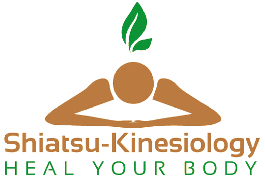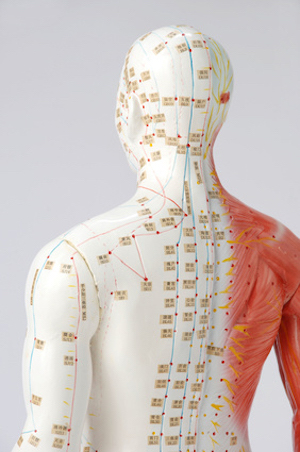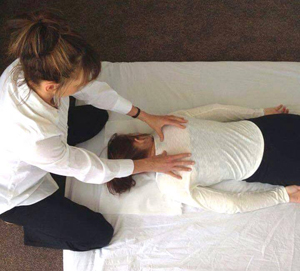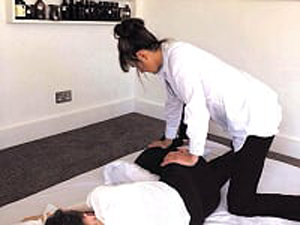What Is Shiatsu?
Shiatsu is a traditional hands-on Japanese healing therapy and is carried out whilst fully clothed. It originated in Japan from Traditional Chinese Medicine, with influences from more recent western therapies. The aim is to restore health by activating the body's self-healing system.
The philosophy underlying Shiatsu is that vital energy (Ki or Chi) flows throughout the body in a series of channels called Meridians. Most of the Meridians are linked to a body organ. When the Ki circulating through the Meridians becomes blocked or depleted, we experience this as a pain or an ailment at a physical or emotional level.
Shiatsu uses the same Meridian pathways/points as Acupuncture, but instead of using needles, the Shiatsu practitioner uses a variety of techniques to improve energy flow. Shiatsu means 'finger pressure' in Japanese, in practice however, a practitioner uses touch and comfortable pressure which includes gentle holding, pressing with palms, thumbs, fingers, elbows, knees and feet, manipulative techniques, and when appropriate more dynamic rotations and stretches, to adjust the body's physical structure and balance its energy flow.
It is a deeply calming experience and regular treatments can alleviate stress. It also may help with with a wide range of health problems including back pain and other structural problems such as improved posture and flexibility, circulation, breathing and mental awareness.
When clients first come for treatments, they often have low energy levels, disturbed sleep, digestive problems or suffer from headaches - clients report huge relief from these problems. It also aids the elimination of toxins and waste products. It is a physical therapy that supports and strengthens the body's natural ability to heal and balance itself. It works on the whole person – not just with the physical body, but also with the psychological and emotional aspects of well-being.
Shiatsu massage is deeply relaxing, so there's no need to have a chronic condition, just come along, lie down and enjoy! Following a treatment, you may have a feeling of increased vitality, feel invigorated and yet relaxed. If requested, diet and lifestyles are studied and advice and recommendations given.
In addition to being regularly used by thousands of people all over the world, a variety of charities, health foundations, NHS trusts and hospitals in the United Kingdom provide Shiatsu to support patients whilst receiving treatment for a range of health issues and to help them maintain their general wellbeing.
My Shiatsu is based on the Five Element Theory of Traditional Chinese Medicine with much focus given to the acupuncture points. I also use Zen Shiatsu.
Sessions
The number of sessions depends on the individual's requirements. If having Shiatsu purely for relaxation purposes, the number and frequency of sessions is entirely up to the client. For therapeutic purposes and to see longer term benefits, it is advised to start off with a series of weekly or fortnightly sessions, and then reduce the frequency to meet their needs.
Please wear loose, comfortable (preferably natural fibre) clothing. It is advisable to abstain from alcohol on the day of a treatment and avoid any strenuous activity, and to remember the importance of drinking plenty of good quality water.
Shiatsu is classically done on a futon mattress on the floor, but I have the option of a regular treatment table or therapy chair if this is necessary.
I have a dedicated, modern treatment room and ample free parking.
History of Shiatsu
Massage, along with acupuncture and herbalism, was for centuries an integral part of Traditional Chinese Medicine. This was introduced to Japan by a Buddhist monk in the 6th century. The Japanese developed and refined many of its methods to suit their own physiology, temperament and climate. In particular, they developed the manual healing and diagnostic arts, evolving special techniques of abdominal diagnosis, treatment and massage, which are used in shiatsu today.
However, the practice of massage known by the old name of Anma (anmo or tuina in China) became gradually divorced from medicine and more associated with relaxation and pleasure. Certain practitioners were concerned to preserve massage and related techniques as an accepted healing art.
In the early part of the 20th century, one such practitioner, Tamai Tempaku, incorporated the newer Western sciences of anatomy and physiology and disciplines such as physiotherapy and chiropractic into several older methods of treatment. Originally he used the term Shiatsu Ryoho or finger pressure way of healing, then Shiatsu Ho or finger pressure method. Now known simply as Shiatsu, it was officially recognized as a therapy by the Japanese Government in 1964, so distinguishing it from Anma and Western massage.
Styles of Shiatsu
Many early Shiatsu practitioners developed their own style and some, including Tokojiro Namikoshi and Shizuto Masunaga, founded schools that helped establish Shiatsu as a therapy.
Today, Shiatsu has a number of different styles, philosophical approaches and theoretical bases and practitioners around the world are still evolving new approaches to treatment. Some concentrate on acupressure (acupuncture) points, while others emphasise more general work on the body or along the pathways of energy to influence the Ki that flows in them. Other styles highlight diagnostic systems, such as the Five Element system or the Macrobiotic approach. However all are fundamentally based on Traditional Chinese Medicine.








